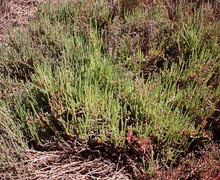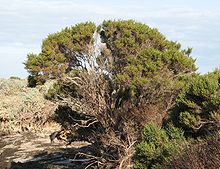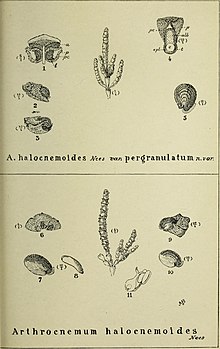Tecticornia
| Tecticornia | |
|---|---|

| |
| Samphire, Tecticornia pergranulata | |
| Scientific classification | |
| Kingdom: | Plantae |
| Clade: | Tracheophytes |
| Clade: | Angiosperms |
| Clade: | Eudicots |
| Order: | Caryophyllales |
| Family: | Amaranthaceae |
| Subfamily: | Salicornioideae |
| Genus: | Tecticornia Hook. f. |
| Species | |
|
ca. 44 species, see text | |
Tecticornia is a genus of
In 2007, the genus Halosarcia, along with three other Australian genera (Pachycornia, Sclerostegia and Tegicornia) was incorporated into the genus.Description




The species of Tecticornia grow as annual or
The spike-shaped inflorescences consist of opposite bracts, mostly connate and stem-clasping, free in some species. Their blades are cup- or collar-like or deltoid to semi-circular scales. In the axil of each bract, there are three to five (rarely one or seven) flowers, free or sometimes fused to each other, to the bract, and to the inflorescence axis. The flowers are hermaphrodite, rarely unisexual. They consist of a 2-3-lobed perianth of connate tepals, one stamen, and an ovary with two stigmas.[2]
In fruit, the perianth remains membranous or becomes crustaceous, spongy, or horny. The fruit wall (pericarp) may be membranous, fleshy, crustaceous, or woody. The seed is disc-shaped or wedge-shaped, its seed coat with smooth or reticulate, tuberculate or longitudinally ribbed surface. The seed contains the curved embryo and copious perisperm (feeding tissue).[2]
Distribution
All species of Tecticornia are distributed in
Systematics
The first publication of Tecticornia was made in 1880 by Joseph Dalton Hooker.[3] The type species of this genus is Tecticornia cinerea (F. Muell.) Baill,[4] which is a synonym of Tecticornia australasica. Tecticornia used to be a small genus with just three species, until in 2007, the genera Halosarcia, Pachycornia, Sclerostegia and Tegicornia were included.[5]
Phylogenetical research of the subfamily Salicornioideae revealed that the Tecticornia/Halosarcia/Pachycornia/Sclerostegia/Tegicornia lineage is a sister group of Sarcocornia/Salicornia.[2]
In 2016, Tecticornia comprises about 44 species,[6] eleven species were described recently.[7][8][9][10][11][12] (distributions as given by Australian Plant Census (2008).[6]
- Tecticornia annelida K.A.Sheph. & M. Lyons - in Western Australia.[11]
- Tecticornia arborea Paul G.Wilson (Bulli Bulli) - in Western Australia.
- Victoria, Tasmania).
- Tecticornia auriculata (Paul G.Wilson) K.A.Sheph. & Paul G.Wilson - in Western Australia.
- Tecticornia australasica (Moq.) Paul G.Wilson - in Northern Territory, Queensland.
- Tecticornia bibenda K.A.Sheph. & S.J.van Leeuwen - in Western Australia.[7]
- Tecticornia bulbosa (Paul G.Wilson) K.A.Sheph. & PaulG.Wilson, (Large-articled Samphire) - Inland growing plant found in Western Australia and listed as being vulnerable to extinction.[13]
- Tecticornia calyptrata (Paul G.Wilson) K.A.Sheph. & Paul G.Wilson - a saline claypans.[14]
- Tecticornia chartacea (Paul G.Wilson) K.A.Sheph. & Paul G.Wilson - in Western Australia.
- Tecticornia cupuliformis (Paul G.Wilson) K.A.Sheph. & Paul G.Wilson - in South Australia, Queensland
- Tecticornia cymbiformis K.A.Sheph. & Paul G.Wilson - in Western Australia.[8]
- Tecticornia disarticulata (Paul G.Wilson) K.A.Sheph. & Paul G.Wilson - Western Australia, Northern Territory, New South Wales, Tasmania.
- Tecticornia doleiformis (Paul G.Wilson) K.A.Sheph. & Paul G.Wilson - in Western Australia.
- Tecticornia entrichoma (Paul G.Wilson) K.A.Sheph. & Paul G.Wilson - in Western Australia.
- Tecticornia fimbriata (Paul G.Wilson) K.A.Sheph. & Paul G.Wilson - in Western Australia.
- Tecticornia flabelliformis (Paul G.Wilson) K.A.Sheph. & Paul G.Wilson, (Bead Samphire or Bead Glasswort) - a woody, perennial, salt-tolerant plant growing up to 20 centimetres high in saltmarshes associated with salt lakes and saline flats and usually in monospecific patches. It is a deciduous shrub with fleshy branches, flowering and fruiting from January to May. T. flabelliformis is found in South Australia, Victoria and Western Australia with most of the population in South Australia. It is nationally listed as being vulnerable to extinction,[15] with state by state listings as vulnerable in South Australia, threatened in Victoria and poorly known in Western Australia.[16] (Eyelash Samphire)
- Tecticornia fontinalis (Paul G.Wilson) K.A.Sheph. & Paul G.Wilson - in South Australia.
- Tecticornia globulifera K.A.Sheph. - in Western Australia.[12]
- Tecticornia halocnemoides (Nees) K.A.Sheph. & Paul G.Wilson, (Shrubby Samphire or Grey Glasswort) - widely distributed in Australia (Western Australia, Northern Territory, South Australia, Queensland, New South Wales, Victoria).
- Tecticornia indefessa K.A.Sheph. - in Western Australia.[9]
- Southeast asia to South Asia, East Africa, Madagascar, southeastern Africa, and Atlantic coast of Senegal.[2]
- Tecticornia laevigata K.A.Sheph. - in Western Australia.[8]
- Tecticornia lepidosperma (Paul G.Wilson) K.A.Sheph. & Paul G.Wilson - in Western Australia, South Australia.
- Tecticornia leptoclada (Paul G.Wilson) K.A.Sheph. & Paul G.Wilson - in Western Australia.
- Tecticornia loriae K.A.Sheph. & M. Lyons - in Western Australia.[11]
- Tecticornia lylei (Ewart & Jean White) K.A.Sheph. & Paul G.Wilson - in Western Australia, South Australia, New South Wales?, Victoria
- Tecticornia medullosa (Paul G.Wilson) K.A.Sheph. & Paul G.Wilson - in South Australia, Queensland, New South Wales.
- Tecticornia medusa K.A.Sheph. - in Western Australia.[12]
- Tecticornia mellaria K.A.Sheph. - in Western Australia.[8]
- Tecticornia moniliformis (Paul G.Wilson) K.A.Sheph. & Paul G.Wilson - in Western Australia, Victoria.
- Tecticornia nitida (Paul G.Wilson) K.A.Sheph. & Paul G.Wilson - in South Australia, Victoria
- Tecticornia papillata K.A.Sheph. - in Western Australia.[10]
- Tecticornia peltata (Paul G.Wilson) K.A.Sheph. & Paul G.Wilson - in Western Australia.
- Tecticornia pergranulata (J.M.Black) K.A.Sheph. & Paul G.Wilson, (Samphire, Blackseed Glasswort or Blackseed Samphire) - found inland across much of Australia and, less often, in coastal saline areas.
- Tecticornia pluriflora (Paul G. Wilson) K.A.Sheph. & Paul G.Wilson - in South Australia, New South Wales
- Tecticornia pruinosa (Paulsen) K.A.Sheph. & Paul G.Wilson - in Western Australia, Northern Territory, South Australia, New South Wales, Victoria.
- Tecticornia pterygosperma (J.M.Black) K.A.Sheph. & Paul G.Wilson - in Western Australia, South Australia, New South Wales, Victoria
- Tecticornia sparagosa K.A.Sheph. & M. Lyons - in Western Australia.[11]
- Tecticornia syncarpa (Paul G.Wilson) K.A.Sheph. & Paul G.Wilson - in Western Australia, South Australia, Victoria.
- Tecticornia tenuis (Benth.) K.A.Sheph. & Paul G.Wilson - in Western Australia, Northern Territory, South Australia, Queensland, New South Wales, Victoria.
- Tecticornia triandra (F.Muell.) K.A.Sheph. & Paul G.Wilson - in Western Australia, Northern Territory, South Australia, Queensland, New South Wales, Victoria.
- Tecticornia undulata (Paul G.Wilson) K.A.Sheph. & Paul G.Wilson - in Western Australia, Northern Territory, South Australia.
- dioecious, with only one flower at each bract,[2]- in Western Australia.
- Tecticornia verrucosa Paul G.Wilson - in Western Australia, Northern Territory, South Australia.
Uses
Young twigs of Tecticornia indica can be cooked and eaten as a vegetable. In Madagascar, they are pickled in vinegar and used as a spice.[17]
References
- Department of Biodiversity, Conservation and Attractions.
- ^ JSTOR 25065639..
- ^ Joseph Dalton Hooker (1880). "Genera Plantarum ad exemplaria imprimis in herbariis Kewensibus", 3(1), p. 65. first description of Tecticornia
- ^ "Tecticornia". Tropicos. Missouri Botanical Garden. Retrieved 15 August 2016.
- doi:10.1071/sb07002.
- ^ a b APC - Australian Plant Census (2008). Tecticornia, CHAH.
- ^ S2CID 89903942.
- ^ S2CID 87758139.
- ^ S2CID 85863238.
- ^ S2CID 90293925.
- ^ S2CID 82328827.
- ^ .
- ^ "Species Profile and Threats Database, Halosarcia bulbosa". Australian Government, Department for Environment and Heritage. Retrieved 2006-10-02.
- ^ "Halosarcia calyptrata". Florabase. Retrieved 2006-10-18.
- ^ "Threatened Flora of Eyre Peninsula" (PDF). Australian Government, Department for Environment and Heritage. Archived from the original (PDF) on 2006-09-20. Retrieved 2006-10-01.
- ^ Department of the environment, Australia (2004). "EPBC Nomination to de-list from the Vulnerable category, Halosarcia flabelliformis (Bead Glasswort)" (PDF). Retrieved 2007-02-07.[permanent dead link]
- ^ Halosarcia indica at PROTA4U Archived 2016-08-01 at the Wayback Machine
External links
 Media related to Tecticornia at Wikimedia Commons
Media related to Tecticornia at Wikimedia Commons
